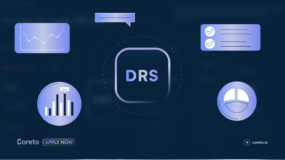
“You can’t go back and change the beginning, but you can start where you are and change the ending.” — C. S. Lewis
In part one of this series, we looked at the birth and explosive growth of blockchain and cryptocurrency as a young technology in the years leading up to 2017, saw the value of Bitcoin skyrocket in 2017 and heavily retrace in 2018, and saw the fortunes of blockchain investors likewise crash on the shores of unreliable and inexperienced ICO projects.
At the moment, the value of Bitcoin is recovering, setting a new ATH for 2019 ($8,100 at the time of writing), and likewise so is confidence in blockchain technology. So then where does it go from here? What do we need to take it into the future while avoiding the pitfalls of the past? What does “Blockchain 2.0” look like?
We may be able to get a glimpse at the future by looking at the past and what “Web 2.0” looked like back in the early 2000’s. What steps did the “World Wide Web” need to take in order to evolve from something largely considered a useful tool into the entity that has become an inextricable part of our daily personal and professional lives?
Web 2.0: Participation & Interactivity
Prior to Web 2.0, the internet was largely a passive, one-way experience. Then blogs came along and offered users a more dynamic way to participate and interact with the web outside of email, chat rooms, bulletin boards, and Usenet newsgroups.
Blogging technology opened the door for anybody to create and share content on the web with the whole world. Services like Blogger, Live Journal, and WordPress allowed normal people to instantly and frequently publish anything from public diaries to electronic magazines to reviews of popular TV shows.
Meanwhile, blog commenting technology allowed people to not only add content to the web but offer feedback on the content of others as well. And all of it as available for the world at large to see as any content created by major entities like the New York Times, Microsoft, or Pepsi.
Blogs formed the leading edge of popular social media platforms like Facebook, Twitter, YouTube, and LinkedIn. The rapid rise of these social networks speaks to a hunger to participate and interact that has only grown over time. According to Statista.com, a third of the world’s population uses some form of social media, and 79% of the U.S. population has at least one social media profile.
Blockchain: Participation & Interactivity
By contrast, participation in blockchain has largely remained a one-sided experience to date. Investors supply ICO project teams with the funds needed to develop, and influencers simply facilitate these transactions by endorsing the projects they deem most likely to succeed.
Interactivity in blockchain has also traditionally been a non-starter. In some rare cases, investors might play an indirect role in the direction a project takes … but not often. Project teams will do whatever they’re going to do with little to no transparency or accountability.
Likewise, content creators have maintained their positions of influence more on the basis of how many followers they have than on how often they get things right, if only because there have been no reliable mechanisms for ranking them.
Web 2.0: Community & Collaboration
Once Web 2.0 opened the doors to participation and interactivity, the spirit of what bulletin boards and Usenet started in the 90s jumped to the next level. By way of internet forums and social media groups, virtual communities have since sprouted up and thrived around everything from gaming to technology to home improvement.
The appeal of these online communities is the sense of collaboration that holds them together. Not sure how to get past that tough level in your favorite video game? Or how to keep your toilet from making that weird noise? Well, somebody else in the world probably does and is more than willing to share with you what they know.
Blockchain: Community & Collaboration
As with the web, communities have formed around discussions of blockchain technology, and particularly around cryptocurrency. The forum “BitcoinTalk” was actually founded by the inventor of Bitcoin itself, Satoshi Nakamoto. In the early days of crypto, this is where new project teams would announce their upcoming ICOs and where investors would come to talk about the potential of new projects and ideas.
Since those early days, though, forums like BitcoinTalk seem to have followed the lead of cryptocurrency itself, falling prey to opportunistic and sometimes unscrupulous ICO projects and pay-for-play influencers. This has greatly diminished the sense of community and collaboration that once connected blockchain enthusiasts, and has instead fostered an atmosphere of fear, uncertainty, and doubt.
Web 2.0: Trust & Reputation
Last but certainly not least, the proliferation of user-created content in the wake of Web 2.0 opened yet another door — this one about the nature of Trust. In a world where literally anybody can publish to the web, which content should we trust? Is something read on a blog more or less trustworthy than a major news outlet? Is Wikipedia a less reliable source of information than the Encyclopedia Britannica?
The sources we choose to trust are the ones with the best reputations. If we trust the New York Times more than some random blog, it’s because they’ve been around and getting it right for a lot longer. Familiarity and a strong track record goes a long way.
Likewise, the way certain content creators on the web become “influencers” is by offering valuable and reliable information. And doing it often enough that thousands or even millions of people trust what they have to say and begin looking to them for guidance.
Blockchain: Trust & Reputation
Public trust in cryptocurrency took a big hit from 2017 to 2018, as a result of a historical drop in the value of Bitcoin, from which it’s still recovering. Similarly, trust in ICO projects also took a hit because of countless bad faith projects that collected millions of dollars from investors but never paid off, either because of inexperience or outright fraud.
Maybe most disappointing, but, was the trust lost by the many content creators and influencers who compromised their integrity and reputation during this period. They did this by either:
- Endorsing projects on the basis of very little actual knowledge or insight in order to build a large follower base that didn’t know any better; or
- Participating in a “pay for play” scenario endorsing projects purely on the basis of compensation by ICO teams rather than merit.
Coreto Offers a Way Forward
The creators of the Coreto platform have experienced firsthand every one of the shortcomings faced by blockchain. From one-sided participation and a lack of interactivity to a breakdown of community, collaboration, and trust.
Yet just as Web 2.0 took the internet to the next level, Coreto (short for COmmunity REward TOken) started development as a solution to carry blockchain into the future. The Coreto developers aim to overcome these shortcomings and more, armed with a toolbox of innovative features that include:
- Staking of Opinion Pool (SOOP)
- Machine Learning / AI
- Gamification
- Direct Access through One-on-Ones with Blockchain Experts
- Rumors Stack
- Instant Updates
- Powerful Security
Let’s take a look at how these features will address the issues already discussed …

Coreto: Participation & Interactivity
Until now, blockchain investors have remained largely passive from a participation standpoint, existing mostly to fund ICO projects, which in turn participate by developing those projects and seeking funds for them. Influencers, of course, have participated by creating content in the form of reviews and recommendations, but this activity has largely been unstructured, carried out across various forums and platforms.
Coreto shakes things up by bringing all three parties together on one user-friendly platform that rewards participation and interactivity.
On Coreto, investors can not only learn more about blockchain, active projects, and the current state of crypto, but also interact directly, even individually, with experts and influencers. What’s more, they have access to the analytics, insights, and prediction capability of the platform’s cutting edge machine learning algorithm. All of which empowers their ability to make sound investment decisions.
“We are a team of solution-oriented minds with a common purpose: to drive adoption for blockchain technology. We believe that improved end to end experience will shape the medium that converts complexity into meaning.”
Iustina Faraon, CEO/CO-Founder Coreto
Influencers, meanwhile, benefit from participation in Coreto’s groundbreaking SOOP (Staking of Opinion Pool) feature, which allows them to “put their tokens where their mouth is” so to speak, by backing their project analyses and price movement predictions with the platform’s own “COR” tokens. Other platform users can even pledge their own tokens to these SOOPs, sharing both the risks and rewards.
Influencers can also choose to take advantage of Coreto’s gamification feature, which encourages healthy competition between these experts. By allowing traders to challenge each other to 1-on-1 “confrontations”, the platform provides a strong incentive and stimulus to create the highest quality content.
Blockchain project teams, meanwhile, can benefit from the increased participation and interactivity features Coreto offers. Not only does the platform let them to more easily interact with the influencers that are so critical to building awareness of their projects, but they themselves can use it to maintain awareness of what’s happening in the blockchain arena and what’s most important to potential investors.
Coreto: Community & Collaboration
Many of the same features that encourage participation and interactivity also serve to build a stronger sense of community among the various blockchain parties. This is, in fact, part of Coreto’s core mission: To unite blockchain investors, influencers, and project teams, and bring new participants into the fold, by providing a social platform that is friendly, easy to use, and enables everybody to thrive.
“We connect people so they can help one another.
We teach, we learn, we earn together. We are building a tribe.”
Besides the SOOP and gamification aspects mentioned previously, influencers will also benefit by being able to bring all of their scattered followers over to one platform. This cuts down on the time and energy needed to manage a presence across multiple forums, while also providing them with a potentially powerful income channel.
What’s more, anybody can become an influencer on Coreto. Simply build a profile, use it to showcase whatever knowledge or experience you have, and begin making predictions. Over time, your followers and COR tokens will grow. And as your trust and reputation build, Coreto will even unlock additional features and options.
Coreto: Trust & Reputation
Which brings us to Coreto’s most critical feature: Trust.
Everything mentioned already feeds into this core principle. Trust in blockchain, cryptocurrency, and its players has been lost. That’s why the creators of Coreto have the motivation to use the immutability and transparency properties of blockchain technology itself to build a reputation-based social platform that bridges the trust gap between blockchain investors, influencers, and project teams.
Coreto is based on the most valuable asset a user can have: TRUST.
This commitment to trust starts from the top down. The Coreto platform utilizes powerful encryption, privacy, and blockchain-based data accuracy to ensure that all user information and transactions remain secure and untampered with. Also, any blockchain rumors posted, are stacking on the platform, minimizing “fake news” and ensuring that only rumors backed by other users will become fact.
Thanks to Coreto’s innovative SOOP and gamification features, influencers and content creators — whether they’ve been at it a while or are new to the game — can finally set up and build their reputation in the blockchain arena. After all, the key difference between a following and a reputation is trust. Can you rely on somebody based not just on how popular they are but on how often they get it right?
Trust and reputation are what Coreto is all about.
Where Do We Go from Here?
As we’ve seen, blockchain and cryptocurrency sit at an important crossroad that isn’t all that far off from the one the web itself faced twenty years ago. Fortunately, the history of the web has proven that obstacles like a lack of interactivity, collaboration, and trust were overcome, and new heights reached, with the proper implementation of solutions.
Coreto understands this better than anybody and creates a future-facing platform that brings trust back to the blockchain community by leveraging many of the same solutions that have continued to make the web such an integral part of our daily lives. Why? Because they believe strongly that twenty years from now, blockchain will be just as integral, if not more so. And that starts now.
The team behind Coreto encourages you to come along for the ride, and join the community that’s helping to carry blockchain and cryptocurrency into the future.
Guest written by Randy Heller
Story Guru for Small Businesses, Startups, and Solopreneurs, found at RandyHeller.com.




